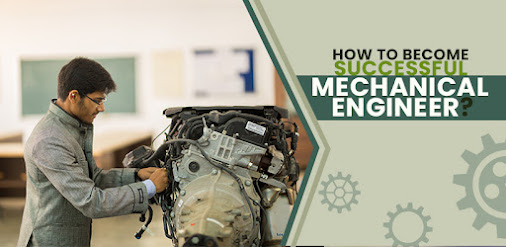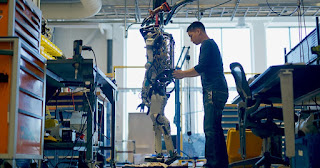Saturday, 11 March 2023
Tuesday, 7 March 2023
Mechanical Engineer at Boston Dynamic
Atlas is a research platform for Boston Dynamics. We use it as a technology demonstrator to push the boundaries of hardware design and control systems. We select applications like dance and parkour to facilitate pushing these boundaries.
HOW FAST CAN ATLAS GO?
The fastest Atlas has run is around 5.5 mph. There’s a running joke here where we keep thinking the robot is at its hardware limits in terms of strength, speed, and flexibility, but then the software team finds a way to do something more athletic and coordinated than we were ever able to before. So we really don’t know how much more we can extend Atlas’s capabilities with its current design.
WHAT WAS THE FIRST PROTOTYPE OF ATLAS?
Boston Dynamics’ first humanoid prototype was called PetProto, which was a precursor to our robot Petman. We took two legs from our robot BigDog and tried to get it to balance; later on, we attached arms. That led to over a decade of humanoid robot evolution to the robot you see on YouTube today, which we refer to internally as HD, short for Humanoid Version D.
Discovering Robots
WHAT GOT YOU INTERESTED IN ROBOTICS?
I was always taking apart and building things as a kid, but I got interested in robotics specifically in high school when I built a drone with a friend. It was pretty terrible and could barely fly, but in learning about flight control and electronics, and seeing the drone responding to my inputs to stabilize itself, I felt really empowered to build more successful robots in the future. In undergrad, I learned a lot of the fundamentals of robotics such as mechanics of materials, physics, machining, thermodynamics, and embedded electronics. I also took every opportunity I could find to build robots through projects, competitions, and research labs. I designed spacecraft mechanisms and robots for the Naval Research Laboratory for five years out of college before coming to Boston Dynamics.&
HOW CAN OTHER YOUNG PEOPLE GET STARTED WITH ROBOTS?
Lego EV3 and FLL (First Lego League) are great entry points for younger kids. If you're in high school, FIRST Tech Challenge (FTC) teams or FIRST Robotics Competition (FRC) teams are awesome. In college, there are tons of opportunities like research labs and undergraduate competitions. And colleges often have great resources and communities to tap into like machine shops, electronics labs, and makerspaces.
Regardless of whether or not you have access to these communities or competitions, take apart everything your parents won't be sad if it breaks. Engines, toasters, computers, fans, old equipment, etc. Probably the most important advice I can give is to just follow your passions. If it excites you and you’re learning, keep following that path, regardless of whether it’s related to robotics or not.
APART FROM SOFTWARE AND ELECTRONICS, HOW MUCH MECHANICS SHOULD YOU STUDY TO APPROACH ROBOTICS?
Nowadays, robotics is highly approachable even if you’re focused in one field instead of all three common to robotics (mechanical, electrical, software). If you want to focus on software, you can buy affordable pre-made kits or robots and spend 90% of your time programming. If you want to focus on mechanics, you can pick projects that don't require complex programming, and use microcontrollers that are simple to program.
Professionally, even as a software engineer or electrical engineer, it’s helpful to understand principles of mechanics like backlash, stiffness, or friction, but you don’t need to be a mechanical designer to develop software or electronics for our robots.
Starting a Career in Robotics
HOW COULD YOU GET INTO ROBOTICS IF YOU'RE IN A FIELD OTHER THAN ENGINEERING?
It depends on what you hope to do with robotics. If you want to work around and with robots, there are lots of non-engineering jobs that can meaningfully interact with robots. For example, there’s robotics presence in the medical, automotive, and media production industries to name a few. If you want to develop robots without being an engineer, it’s a little harder, but there are needs for advisors in non-engineering fields. For example, a physical therapist might work with engineers to develop a rehabilitation robot. If you want to actually design the robots, you’ll need to learn a lot of the fundamentals and likely get a degree in a relevant field like mechanical engineering, software engineering, or electrical engineering.
visit: https://cad-conferences.sciencefather.com/
#mechanical #engineering #mechanicalengineering #mechanic #engineer #engineeringlife #manufacturing #technology #mechanics #mechaniclife #engineers #electrical #design #mechanicals #mechanicalengineer #mechanicproblems #mechanicalengineers #science #mechanicalbull #mechanicaldesign #mechanicalpencil #industrial #machine #electricalengineering #worldofengineering #innovation #mechanicgirl #engineeringproblems
Thursday, 2 March 2023
CNC MACHINING
CNC 101: The term CNC stands for 'computer numerical control', and the CNC machining definition is that it is a subtractive manufacturing process that typically employs computerized controls and machine tools to remove layers of material from a stock piece—known as the blank or workpiece—and produces a custom-designed part. This process is suitable for a wide range of materials, including metals, plastics, wood, glass, foam, and composites, and finds application in a variety of industries, such as large CNC machining, machining of parts and prototypes for telecommunications, and CNC machining aerospace parts, which require tighter tolerances than other industries. Note there is a difference between the CNC machining definition and the CNC machine definition—one is a process and the other is a machine. A CNC machine (sometimes incorrectly referred to as a C and C machine) is a programmable machine that is capable of autonomously performing the operations of CNC machining.
-->Interested in CNC Machining Services? Try out Xometry's Instant Quoting Engine℠ to make your project come to life. Free shipping in the USA.
CNC machining as a manufacturing process and service is available worldwide. You can readily find CNC machining services in Europe, as well as in Asia, North America, and elsewhere around the globe.
Subtractive manufacturing processes, such as CNC machining, are often presented in contrast to additive manufacturing processes, such as 3D printing, or formative manufacturing processes, such as liquid injection molding. While subtractive processes remove layers of material from the workpiece to produce custom shapes and designs, additive processes assemble layers of material to produce the desired form and formative processes deform and displace stock material into the desired shape. The automated nature of CNC machining enables the production of high precision and high accuracy, simple parts and cost-effectiveness when fulfilling one-off and medium-volume production runs. However, while CNC machining demonstrates certain advantages over other manufacturing processes, the degree of complexity and intricacy attainable for part design and the cost-effectiveness of producing complex parts is limited.
While each type of manufacturing process has its advantages and disadvantages, this article focuses on the CNC machining process, outlining the basics of the process, and the various components and tooling of the CNC machine. Additionally, this article explores various mechanical CNC machining operations and presents alternatives to the CNC machining process.
At a glance, this guide will cover:
- Overview of CNC Machining Process
- Types of CNC Machining Operations
- CNC Machining Equipment and Components
- CNC Machining Materials
- CNC Size Considerations
- Alternatives to Using a CNC Machine
- History of CNC Machining
Are you between jobs right now or an employer looking to hire? We've got you covered with our in-depth collections of resources for industrial job seekers and employers looking to fill roles. If you have an open position, you can also fill out our form for a chance to have it featured in the Thomas Monthly Update newsletter.
Overview of CNC Machining Process
Evolving from the numerical control (NC) machining process which utilized punched tape cards, CNC machining is a manufacturing process which utilizes computerized controls to operate and manipulate machine and cutting tools to shape stock material—e.g., metal, plastic, wood, foam, composite, etc.—into custom parts and designs. While the CNC machining process offers various capabilities and operations, the fundamental principles of the process remain largely the same throughout all of them. The basic CNC machining process includes the following stages:
- Designing the CAD model
- Converting the CAD file to a CNC program
- Preparing the CNC machine
- Executing the machining operation
CAD Model Design
The CNC machining process begins with the creation of a 2D vector or 3D solid part CAD design either in-house or by a CAD/CAM design service company. Computer-aided design (CAD) software allows designers and manufacturers to produce a model or rendering of their parts and products along with the necessary technical specifications, such as dimensions and geometries, for producing the part or product.
Designs for CNC machined parts are restricted by the capabilities (or inabilities) of the CNC machine and tooling. For example, most CNC machine tooling is cylindrical therefore the part geometries possible via the CNC machining process are limited as the tooling creates curved corner sections. Additionally, the properties of the material being machined, tooling design, and workholding capabilities of the machine further restrict the design possibilities, such as the minimum part thicknesses, maximum part size, and inclusion and complexity of internal cavities and features.
Once the CAD design is completed, the designer exports it to a CNC-compatible file format, such as STEP or IGES.
CNC Machining Tolerances Tables
When specifying parts to a machine shop, it's important to include any necessary tolerances. Though CNC machines are very accurate, they still leave some slight variation between duplicates of the same part, generally around + or - .005 in (.127 mm), which is roughly twice the width of a human hair. To save on costs, buyers should only specify tolerances in areas of the part that will need to be especially accurate because they will come into contact with other parts. While there are standard tolerances for different levels of machining (as shown in the tables below), not all tolerances are equal. If, for example, a part absolutely cannot be larger than the measurement, it might have a specified tolerance of +0.0/-0.5 to show it can be slightly smaller, but no larger in that area.
mechanicalengineering #innovation #automotive #engine #engineer #electronics #industry #machine #cnc #mechanic #automobile #manufacturing #civilengineering #metalwork #robotics #electrical #engineers #mechanical #mechanicalengineering #automation #autocad
visit; https://cad-conferences.sciencefather.com/
New Machine Learning Method Refines Peach Fruit Quality Trait Analysis
Newswise — Peach ( Prunus persica ) is an economically important fruit, and understanding the genetic basis of its quality traits is cruc...

-
CNC MACHINING CNC 101: The term CNC stands for 'computer numerical control', and the CNC machining definition is that it is a su...
-
Gears play a critical role in mechanical engineering, serving as essential components in various machines and mechanisms to transmit power...
-
Optical MEMS technology integrates mechanical elements, electronics, and sensors on a silicon substrate through microfabrication, enabling...




